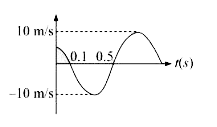In a Young's double slit experiment with slit separation 0.1 mm, one observes a bright fringe at angle 140 rad by using light of wavelength λ1. When the light of wavelength λ2 is used a bright fringe is seen at the same angle in the same set up. Given that λ1andλ2 are in visible range (380 nm to 740 nm), their values are :
600 nm, 750 nm
625 nm, 800 nm
600 nm, 800 nm
380 nm, 500 nm
The correct Answer is:B

θ=yD
140=n1λ1DdD
140=n1λ1d=n1λ10.1×10−3⇒n1λ1=10−440=10000040nm=2500nm
λ=2500n
n=1→λ=2500,n=2→λ=1250
n=3→λ=800,n=4→λ=625
n = 5 to lamda = 500 , lamda = 625,800
Topper's Solved these Questions
Similar Questions
The velocity time graph of a particle executing SHM is shown. The maximum acceleration of the particle is nπm/s2, where n is______.

View SolutionAn engine has an efficiency of 16. When the temperature of sink is reduced by 62∘C, its efficiency id doubled. Temperature of the source is
View SolutionIn a Young's double slit experiment with slit separation 0.1 mm, one observes a bright fringe at angle 140 rad by using light of wavelength λ1. When the light of wavelength λ2 is used a bright fringe is seen at the same at the same angle in the same set up. Given that λ1andλ2 are in visible range (380 nm to 740 nm), their values are :
View SolutionIn a Young's double slit experiment with slit separation 0.1 mm, one observes a bright fringe at angle 140 rad by using light of wavelength λ1. When the light of wavelength λ2 is used a bright fringe is seen at the same at the same angle in the same set up. Given that λ1andλ2 are in visible range (380 nm to 740 nm), their values are :
View SolutionIf the eighth bright band due to light of wavelength λ1 and coincides with ninth bright band from light of wavelength λ2 is young's double slit experiment, then the possible wavelength of visible light are
View SolutionIn the experiment of interfernece, p is the number of bright bands for a light of wavelength λ1. If the source of light is replaced by λ2 then the number of bright bands will be
View SolutionIn a biprism experiment, if the 6th bright bannd with a wavelength λ1 coincides with 7th dark band with a wavelength λ2, then the ratio of the wavelengths (λ1λ2) is
View SolutionIn Young's double slit experiment, two wavelength λ1=780nm and λ2=520 nm are used to obtain interference fringes. If the nth bright band due to λ1 coincides with (n+1)th bright band due to λ2 then the value of n is
View SolutionIn a Young’s double slit experiment with Slit separation 0.1 mm, one observes a bright fringe at angle 140 rad by using light of wavelength λ1 When the light of wavelength λ2 is used a bright fringe is seen at the same angle in the same set up. Given that are in range 600 nm to 900nm, their values are:
View Solutionयंग के द्विस्लिट प्रयोग में तरंगदैर्ध्य λ1 की सातवीं चमकीली फ्रिन्ज दुरी d1 पर है तथा तरंगदैर्ध्य λ2 की सातवीं चमकीली फ्रिन्ज दुरी d2 पर है तो d1/d2 का मान होगा :
View SolutionLight consisting of a plane waves of wavelength, lamda_(1)=8xx10^(-5)cmandlamda_(2)=6xx10^(-5)cm generates an interference pattern in Young's double slit experiment. If n_(1) denotes the n_(1) th dark fringe due to light of wavelength lamda_(1) which coincides with n_(2) th bright fringe due to light of wavelength lamda_(2) , then
View Solutionएक यंग द्वि-झिर्री प्रयोग, जिसमे झिर्रियों के बीच की दूरी 0.1 mm है, तरंगदैर्ध्य λ1 के प्रकाश द्वारा 140 rad कोण पर दीप्त फ्रिन्ज देखि जाती है। जब इसी प्रयोग में λ2 तरंगदैर्ध्य के प्रकाश का उपयोग करते है, तो उसी कोण पर दीप्त फ्रिन्ज देखी जाती है। दिया है कि λ1 तथा λ2 दृश्य प्रकाश के परास (380 nm से 740 nm तक) में है, तो उनके मान होंगे
View Solutionlamda_(1) and lamda_(2) are used to illuminated the slits. beta_(1) and beta_(2) are the corresponding fringe widths. The wavelength lamda_(1) can produce photoelectric effect when incident on a metal. But the wavelength lamda_(2) cannot produce photoelectric effect. The correct relation between beta_(1) and beta_(2) is
View Solutionλ1 and λ2 are used to illuminated the slits. β1 and β2 are the corresponding fringe widths. The wavelength λ1 can produce photoelectric effect when incident on a metal. But the wavelength λ2 cannot produce photoelectric effect. The correct relation between β1 and β2 is
View SolutionTwo wavelengths λ1 and λ2 are used in Young's double slit expt. λ1=430nm. What is the value of λ2 if 4th bright band of one coincides with 6th bright band of the other?
View Solutionएक यंग द्वि-झिरी प्रयोग जिसमें झिर्रियों के बीच की दूरी 0.1 mm, है, तरंगदैर्ध्य λ1 के प्रकाश द्वारा 140 rad कोण पर दीप्त फ्रिन्ज देखी जाती है। जब इसी प्रयोग में λ2 तरंगदैर्ध्य के प्रकाश का उपयोग करते हैं तो उसी कोण पर दीप्त फ्रिन्ज देखी जाती है। दिया है कि तथा दृश्य प्रकाश के परास (380 nm से 740 nm तक) में हैं। तो उनके मान होंगे
View Solution

